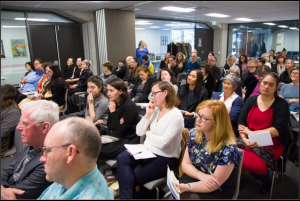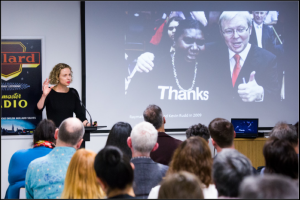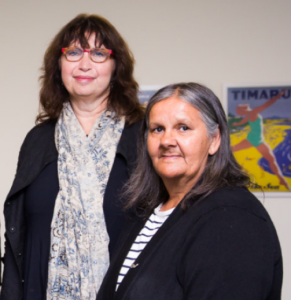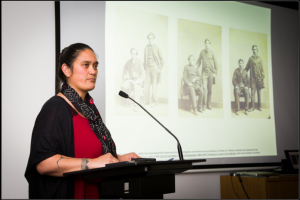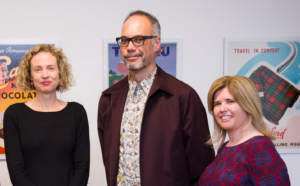Stimulating symposium on Indigenous Photographic Histories
Practitioners, curators, archivists, scholars and others flocked to the Indigenous Photographic Histories Symposium held at the National Library in Wellington on 5 November, an immensely successful one-day event co-organized by Paul Diamond (Alexander Turnbull Library), Angela Wanhalla (CROCC/University of Otago) and Jane Lydon (University of Western Australia, Perth).
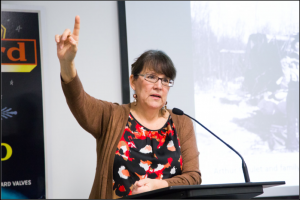
Keynote speaker: Professor Sherry Farrell Racette. Photo: Mark Beatty, Imaging Services, National Library
The symposium kicked off with two keynotes. The first, Professor Sherry Farrell Racette (Manitoba) on “Enclosing some Snapshots”: James P. Brady, Photography and Political Activism, showed how photography was such an integral part of the work of this well-known Métis activist. A self-taught community-based photographer, Brady used it record Metis life at a time when these communities were impoverished and its people lacked rights.
Professor Jane Lydon then gave Aboriginal Transformations of the Photographic Archive on how Aboriginal communities are now using historic photographs. She traced the emotional and healing properties of photographs, and echoing Sherry Farrell Racette’s keynote, pointed to the link between photography, rights and political activism. Drawing upon her Australian Research Council-funded project that identifies and returns Aboriginal photographs held in European collections, Jane noted that while photographs carry the burden of the colonial past, Aboriginal families see them as ways to connect with family and place. To read more about that ARC project have a look at the website: Returning Photographs: Australian Aboriginal Photographs from European Collections
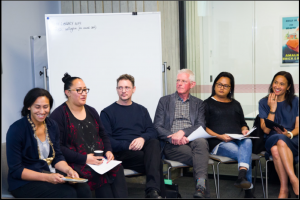
From left: Edith Amituanai, Nina Tonga, Brook Andrew, Paul McNamara, Yuki Kihara, and Jeanette Wikaira. Photo: Mark Beatty, Imaging Services, National Library
After morning tea, a panel of shorter talks ensued, first from three practitioners/artists: Edith Amituanai (Unitec), on the ethics of taking photographs in terms of her own work. Edith spoke about her community-based photography, recording Samoan people and their everyday lives in New Zealand and beyond. She gave us one of the most evocative sentences of the day when she described a photograph as an ‘incomplete utterance of a sentence’; Brook Andrew of Wiradjuri (Monash) discussed the complexities of representation, and his own obsession with the colonial archives, which he uses in his artwork; and Yuki Kihara gave a tour-de-force presentation on the intellectual work underpinning her recent “A Study of a Samoan Savage”, which was inspired by early “scientific” photographs of Samoans in the archive. These were followed by reflections from three people who deal with collections: Paul McNamara on how photographers had utilized the archives in various exhibitions at the McNamara Gallery in Whanganui; Nina Tonga, Te Papa’s Curator Pacific Cultures, on the photography of George Crummer, a trader in the Cook Islands from 1890; and Jeanette Wikaira, Kaituitui Ratonga Māori on how Kai Tahu families interact with the photographic archives of the Hocken Library.
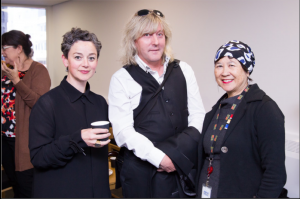
Helen Brown (left) enjoying a break in proceedings with Lyndon Fraser (Canterbury University), and Lynette Shum, Oral History Advisor at the Turnbull. Photo: Mark Beatty, Imaging Services, National Library
The suite of papers reflected on community, place and family. Natalie Robertson of AUT was unable to be at the symposium, but her Siting Mauri through Living Film and Photography using material relating to Ngāti Porou and the Waiapu River was wonderfully and elegantly presented for her by AUT doctoral candidate and photographer Ngahuia Harrison. Helen Brown of Ngai Tahu Archives presented on Wiremu Teira and his Māori Friends where she discussed the Pākehā writer and photographer William A. Taylor and his relationships with Ngāi Tahu communities.
New Zealanders are probably unaware that Aboriginal families, not allowed to live alongside white Australians were relegated to “fringe camps” on the outskirts of outback towns. Karen Hughes (Swinburne University) and renowned Ngarrindjeri weaver Aunty Ellen Trevorrow (Camp Coorong Race Relations Cultural Education Centre) showed life in Ngarrindgeri camps through the intimate and familial portraits made by Aboriginal women photographers.
Chanel Clarke, Māori Curator, Auckland Museum, rounded off the after-lunch session with Dressing the Part: Queen Victoria’s Māori Subjects, on the intersections of dress, photography and colonialism during a visit of Māori to England in the early 1860s. The symposium was lucky to have three “keynote listeners” who all gave their impressions and reflections on the earlier sessions: Damon Salesa (Auckland), Jo Smith (Victoria), and Tina Makereti (novelist, Curator Māori, Museums Wellington). All three touched upon several important themes that united all the presentations: the affective power of photography, the ethics of photography, the rich and varied methodologies being deployed, and the ongoing power of colonial images in the present day.
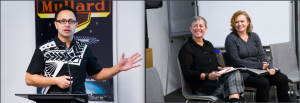
Wonderful “keynote listeners”: Damon Salesa, Jo Smith, and Tina Makereti. Photos: Mark Beatty, Imaging Services, National Library
It was wonderful to be exposed to insights from so many indigenous scholars and practitioners. It was also gratifying to hear how indigenous communities are now using the photographic archives, even those heavily underlain with the violence of colonialism, for their own purposes, as art, for rediscovering histories, and reconnecting communities.
Erik Olssen’s Working Lives, National Radio review
Gyles Beckford reviewed Erik Olssen’s Working Lives c. 1900 a photographic essay today on National Radio’s Nine to Noon programme with Kathryn Ryan. They described this as “a great book”. Emeritus Professor Erik Olssen is a treasured member of CROCC. Click here to listen to the review. (Length 4′ 44″.)

